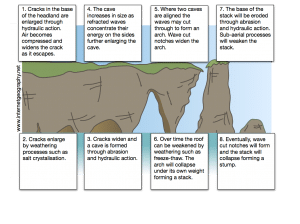Landforms of Coastal Erosion Flashcards
The sea attacks a weakness in the base of the cliff. For example, this could be a joint in chalk. A wave-cut notch is created by erosional processes such as hydraulic action and abrasion. As the notch becomes larger the cliff becomes unstable and collapses as the result of gravity. The cliff retreats inland. The material from the collapsed cliff face is eroded and transported away. This leaves a wave-cut platform. The process repeats over time.
Find out more about the formation of a wave-cut platform.
A concordant coastline is where the same rock runs along the length of the coast. Concordant coastlines tend to have fewer bays and headlands.
Find out more about concordant coastlines.
Find out more about the erosion of a headland.
The bands of soft rock, such as sand and clay, erode more quickly than those of more resistant rock, such as chalk. This leaves a section of land jutting out into the sea called a headland. The areas where the soft rock has eroded away, next to the headland, are called bays.
Find out more about bays and headlands.
Headlands form along discordant coastlines.
Find out more about discordant coastlines.

